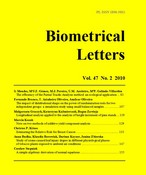
Biometrical Letters vol. 47(2), 2010, pp. 83-106


In this paper we present a Partial Triadic Analysis (PTA) method that can be applied to the analysis of series of ecological tables. The aim of this method is to analyse a three-way table, seen as a sequence of two-way tables. PTA belongs to the family of STATIS methods and comprises three steps: the interstructure, the compromise and the trajectories. The advantage of this method is related to the fact that it works with original data instead of operators, which permits all the interpretations to be performed in a directly way. In this study we present an efficient application of the PTA method in the simultaneous analysis of several data tables and show how well-adapted it is to the treatment of spatio-temporal data. Two kinds of matrices were constructed: a species abundance table and an environmental variables table. Both matrices had the sampling sites in rows. All computations and graphical displays were performed with the free software ADE-4. An example with phytoplankton and environmental factors data is analysed, and the results are discussed to show how this method can be used to extract the stable part of species and environment relationships.

Partial triadic analysis, multi-table analysis, STATIS, species abundance, environmental factors

